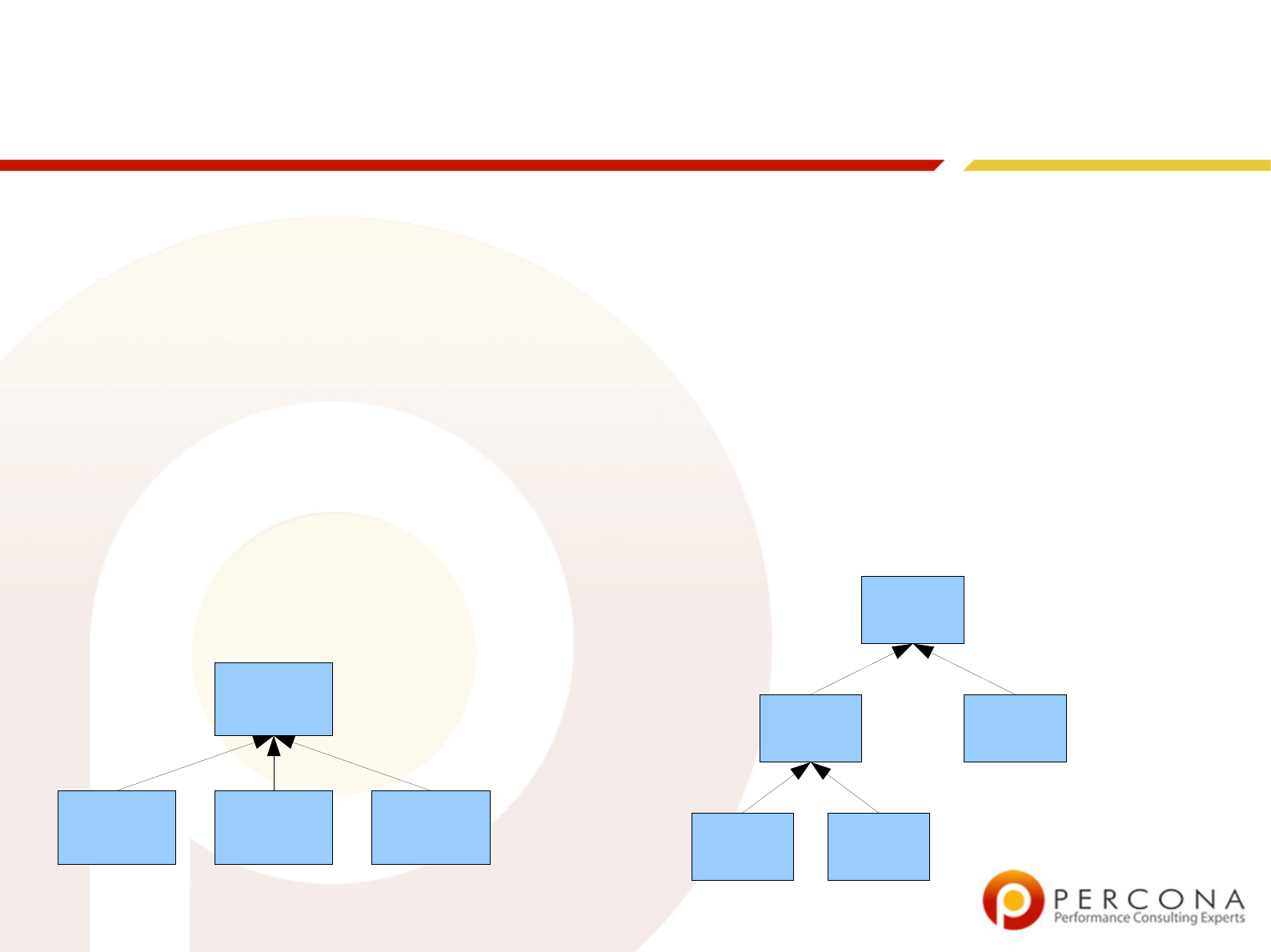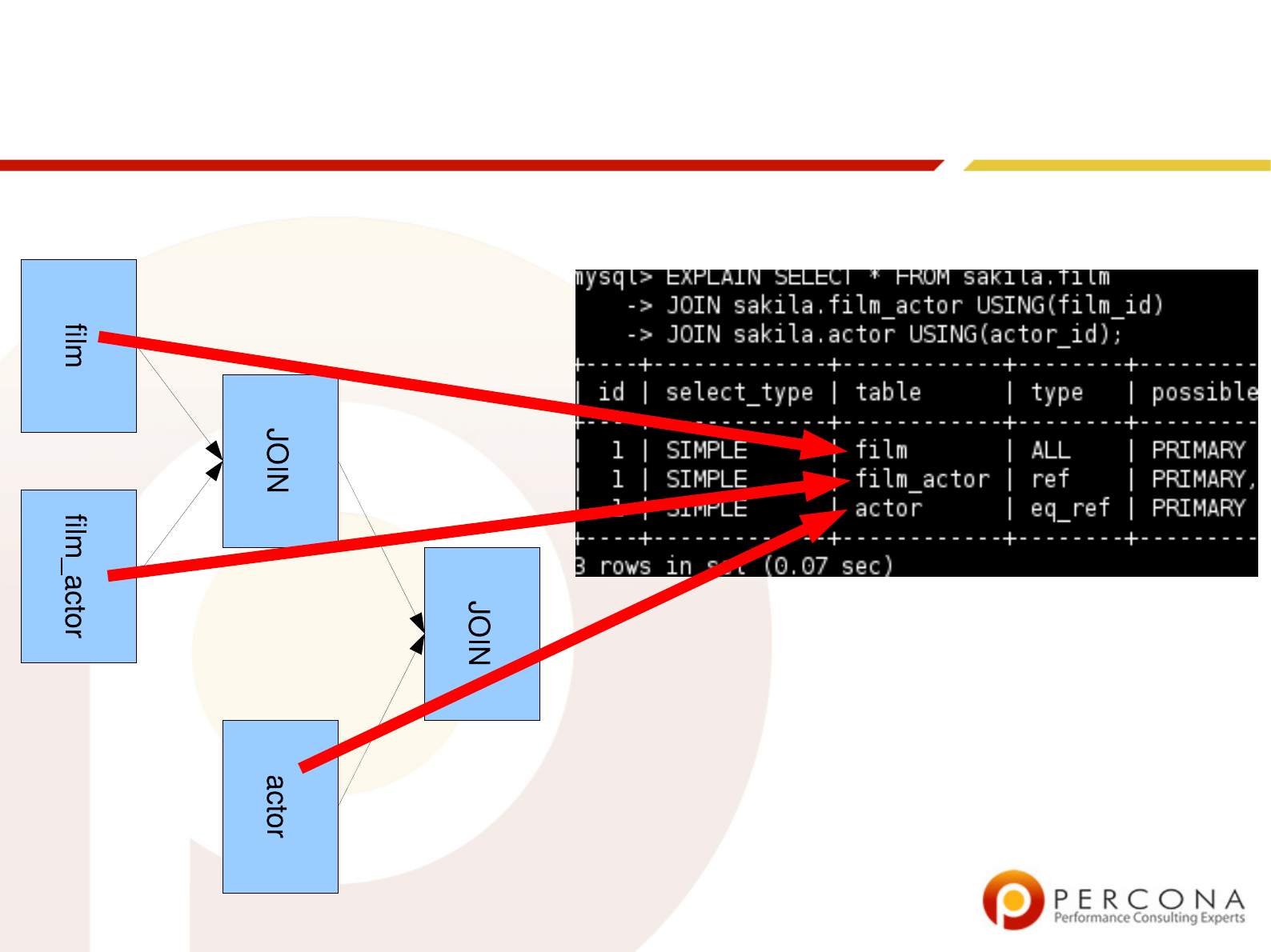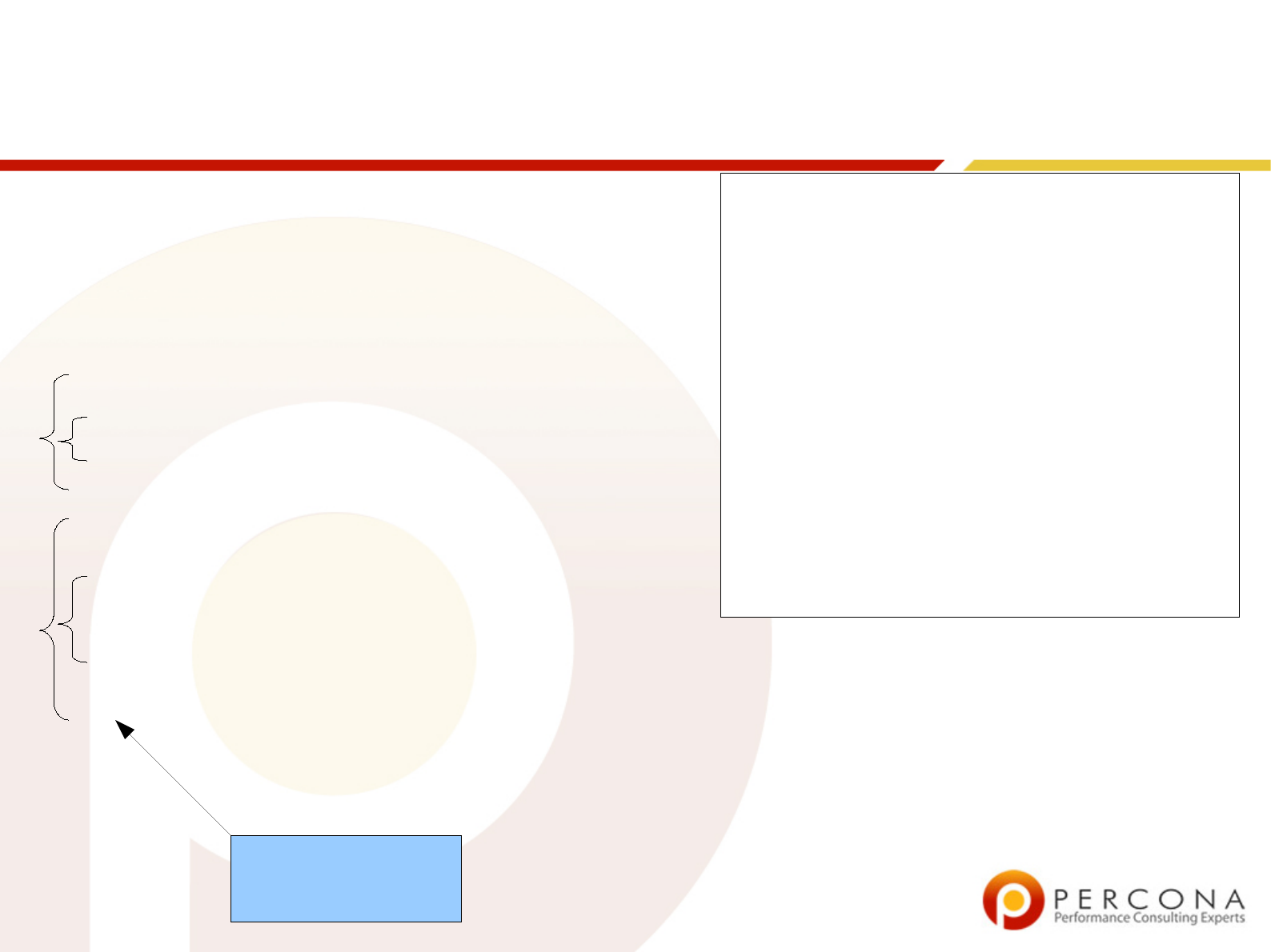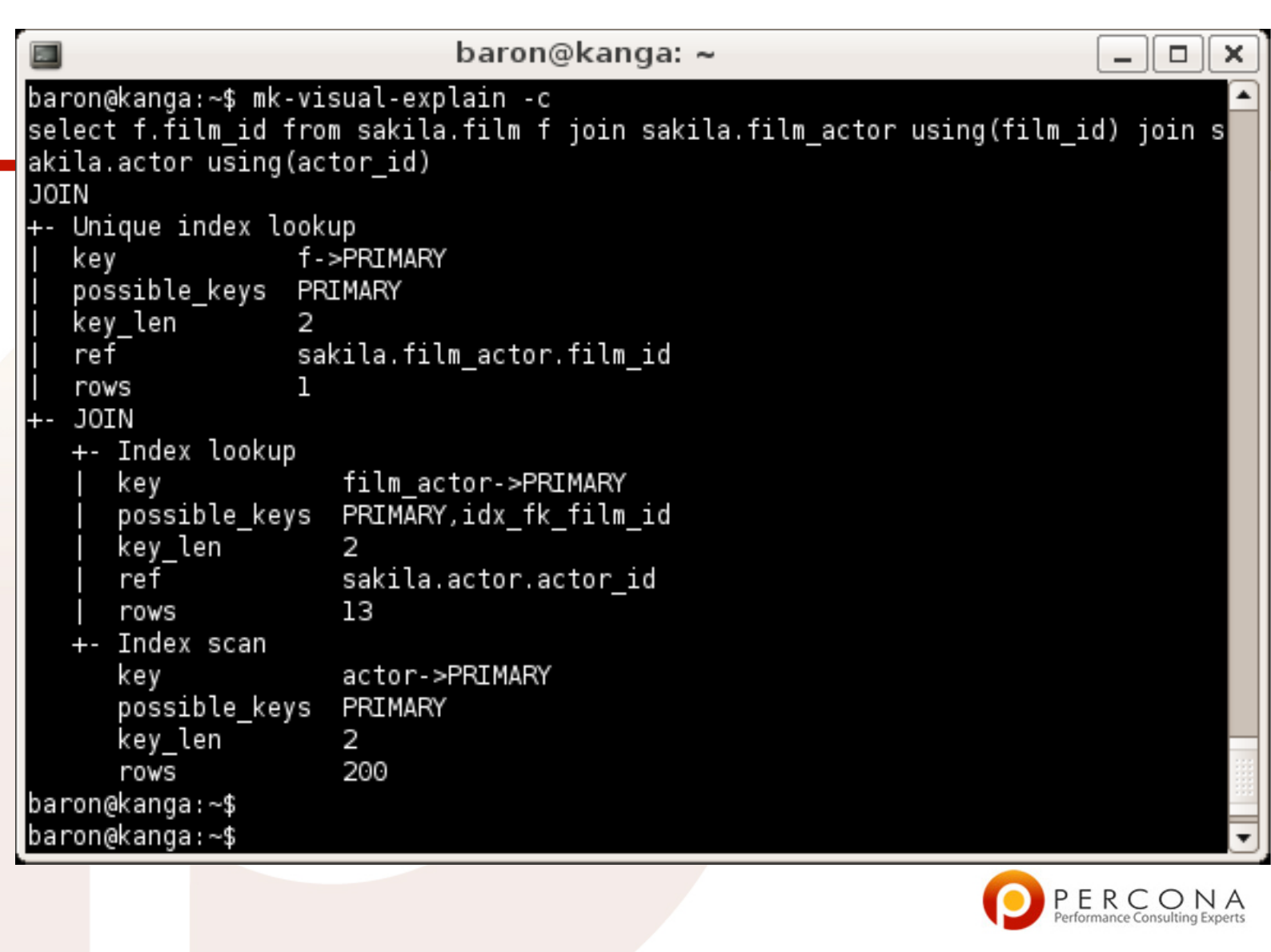
EXPLAIN Demystified
Baron Schwartz
Percona Inc

EXPLAIN Demystified
Outline
• What is EXPLAIN?
• How MySQL executes queries
• How the execution plan becomes EXPLAIN
• How to reverse-engineer EXPLAIN
• Hopelessly complex stuff you'll never remember
• Cool tricks

EXPLAIN Demystified
What is EXPLAIN?
• Shows MySQL's estimated query plan
• Only works for SELECT queries
mysql> explain select title from sakila.film where film_id=5\G
*************************** 1. row ***************************
id: 1
select_type: SIMPLE
table: film
type: const
possible_keys: PRIMARY
key: PRIMARY
key_len: 2
ref: const
rows: 1
Extra:

EXPLAIN Demystified
But first...
• How does MySQL execute queries?
• SQL => Parse Tree => Execution Plan
• Executioner looks at Execution Plan
• Executioner makes calls to Storage Engines
• MySQL does NOT generate byte-code!

EXPLAIN Demystified
The Execution Plan
• SELECT... sakila.film
JOIN sakila.film_actor USING(film_id)
JOIN sakila.actor USING(actor_id)
film film_actor actor
JOIN
One way to do it
film film_actor
actorJOIN
JOIN
The MySQL Way (TM)

EXPLAIN Demystified
Where EXPLAIN comes from

EXPLAIN Demystified
Generating EXPLAIN
• MySQL actually executes the query
• But at each JOIN, instead of executing, it fills the
EXPLAIN result set
• What is a JOIN?
–
Everything is a JOIN, because MySQL always uses nested-
loops
–
Even a single-table SELECT or a UNION or a subquery

EXPLAIN Demystified
The Columns in EXPLAIN
• id: which SELECT the row belongs to
–
If only one SELECT with no subquery or UNION, then
everything is 1
–
Otherwise, generally numbered sequentially
–
Simple/complex types
• simple: there is only one SELECT in the whole query
•
3 subtypes of complex: subquery, derived, union.
– subquery: numbered according to position in SQL text
– derived (subquery in the FROM clause): executed as a temp
table
– union: rows are spooled into a temp table, then read out with a
NULL id in a row that says UNION RESULT

EXPLAIN Demystified
The Columns in EXPLAIN
• simple subquery
mysql> EXPLAIN SELECT (SELECT 1
FROM sakila.actor LIMIT 1) FROM
sakila.film;
+----+-------------+-------+...
| id | select_type | table |...
+----+-------------+-------+...
| 1 | PRIMARY | film |...
| 2 | SUBQUERY | actor |...
+----+-------------+-------+...

EXPLAIN Demystified
The Columns in EXPLAIN
• derived table
mysql> EXPLAIN SELECT film_id FROM
(SELECT film_id FROM sakila.film) AS der;
+----+-------------+------------+...
| id | select_type | table |...
+----+-------------+------------+...
| 1 | PRIMARY | <derived2> |...
| 2 | DERIVED | film |...
+----+-------------+------------+...

EXPLAIN Demystified
The Columns in EXPLAIN
• Union
mysql> EXPLAIN SELECT 1 UNION ALL
SELECT 1;
+------+--------------+------------+...
| id | select_type | table |...
+------+--------------+------------+...
| 1 | PRIMARY | NULL |...
| 2 | UNION | NULL |...
| NULL | UNION RESULT | <union1,2> |...
+------+--------------+------------+...

EXPLAIN Demystified
The Columns in EXPLAIN
• select_type shows whether it's a simple or complex
select, and which type of complex select (PRIMARY,
SUBQUERY, DERIVED, UNION, UNION RESULT)
•
Special UNION rules: first contained SELECT has
the same type as the outer context
–
e.g. the first row in a UNION contained within a subquery
in the FROM clause says “DERIVED”
• Dependences and uncacheability
–
{DEPENDENT,UNCACHEABLE} {SUBQUERY,UNION}
– Uncacheable refers to the Item_cache, not query cache

EXPLAIN Demystified
The Columns in EXPLAIN
• table: the table accessed, or its alias
• More complicated when there's a derived table
–
<derivedN>, where N is the subquery's id column
–
Always a forward reference: the child rows are later in the
output
•
Also complicated by a UNION
–
<union1,2,3...> in the UNION RESULT, where the
referenced ids are parts of the UNION
–
Always a backwards reference: the referenced ids are
earlier in the output

EXPLAIN Demystified
Are You Ready For This?
+------+----------------------+------------+...
| id | select_type | table |...
+------+----------------------+------------+...
| 1 | PRIMARY | <derived3> |...
| 3 | DERIVED | actor |...
| 2 | DEPENDENT SUBQUERY | film_actor |...
| 4 | UNION | <derived6> |...
| 6 | DERIVED | film |...
| 7 | SUBQUERY | store |...
| 5 | UNCACHEABLE SUBQUERY | rental |...
| NULL | UNION RESULT | <union1,4> |...
+------+----------------------+------------+...

EXPLAIN Demystified
Are You Ready For This?
+------+----------------------+------------+...
| id | select_type | table |...
+------+----------------------+------------+...
| 1 | PRIMARY | <derived3> |...
| 3 | DERIVED | actor |...
| 2 | DEPENDENT SUBQUERY | film_actor |...
| 4 | UNION | <derived6> |...
| 6 | DERIVED | film |...
| 7 | SUBQUERY | store |...
| 5 | UNCACHEABLE SUBQUERY | rental |...
| NULL | UNION RESULT | <union1,4> |...
+------+----------------------+------------+...

EXPLAIN Demystified
Are You Ready For This?
+------+----------------------+------------+...
| id | select_type | table |...
+------+----------------------+------------+...
| 1 | PRIMARY | <derived3> |...
| 3 | DERIVED | actor |...
| 2 | DEPENDENT SUBQUERY | film_actor |...
| 4 | UNION | <derived6> |...
| 6 | DERIVED | film |...
| 7 | SUBQUERY | store |...
| 5 | UNCACHEABLE SUBQUERY | rental |...
| NULL | UNION RESULT | <union1,4> |...
+------+----------------------+------------+...
●
Boundaries of UNION:
first id, last id (back ref)
●
Boundaries of
DERIVED: every
subsequent id (forward
ref)
●
>= to the DERIVED id
Huh?

EXPLAIN Demystified
SQL, If You Want To Study
EXPLAIN
SELECT actor_id,
(SELECT 1 FROM sakila.film_actor
WHERE film_actor.actor_id = der_1.actor_id LIMIT 1)
FROM (
SELECT actor_id
FROM sakila.actor LIMIT 5
) AS der_1
UNION ALL
SELECT film_id,
(SELECT @var1 FROM sakila.rental LIMIT 1)
FROM (
SELECT film_id,
(SELECT 1 FROM sakila.store LIMIT 1)
FROM sakila.film LIMIT 5
) AS der_2;

EXPLAIN Demystified
The Columns in EXPLAIN
• type: the “join type”
• Really, the access type: how MySQL will access the
rows to find results
• From worst to best
–
ALL, index, range, ref, eq_ref, const, system, NULL
mysql> EXPLAIN SELECT ...
id: 1
select_type: SIMPLE
table: film
type: range

EXPLAIN Demystified
The Columns in EXPLAIN
• possible_keys: which indexes looked useful to the
optimizer
–
the indexes that can help make row lookups efficient
• key: which index(es) the optimizer chose
– the index(es) the optimizer chose to minimize overall query
cost
–
not the same thing as making row lookups efficient!
–
optimizer cost metric is based on disk reads

EXPLAIN Demystified
The Columns in EXPLAIN
• key_len: the number of bytes of the index MySQL will
use
–
MySQL uses only a leftmost prefix of the index
– multibyte character sets make byte != character
mysql> EXPLAIN SELECT ...
table: film
type: range
possible_keys: PRIMARY
key: PRIMARY
key_len: 2

EXPLAIN Demystified
The Columns in EXPLAIN
• ref: which columns/constants from preceding tables
are used for lookups in the index named in the key
column
mysql> EXPLAIN
-> SELECT STRAIGHT_JOIN f.film_id
-> FROM sakila.film AS f
-> INNER JOIN sakila.film_actor AS fa
-> ON f.film_id=fa.film_id AND fa.actor_id = 1
-> INNER JOIN sakila.actor AS a USING(actor_id);
...+-------+...+--------------------+---------+------------------------+...
...| table |...| key | key_len | ref |...
...+-------+...+--------------------+---------+------------------------+...
...| a |...| PRIMARY | 2 | const |...
...| f |...| idx_fk_language_id | 1 | NULL |...
...| fa |...| PRIMARY | 4 | const,sakila.f.film_id |...
...+-------+...+--------------------+---------+------------------------+...

EXPLAIN Demystified
The Columns in EXPLAIN
• rows: estimated number of rows to read
–
for every loop in the nested-loop join plan
–
doesn't reflect LIMIT in 5.0 and earlier
• NOT the number of rows in the result set!
mysql> EXPLAIN SELECT * FROM
sakila.film WHERE film_id > 50
rows: 511
Extra: Using where

EXPLAIN Demystified
The Columns in EXPLAIN
• filtered: percentage of rows that satisfy a condition,
in 5.1 only
• in most cases will be 0 or 100
• too complicated to explain

EXPLAIN Demystified
The Columns in EXPLAIN
• The Extra column: very important!
• Some possible values
–
Using index: covering index
–
Using where: server post-filters rows from storage engine
–
Using temporary: an implicit temporary table (for sorting or
grouping rows, DISTINCT)
• No indication of whether the temp table is on disk or in memory
–
Using filesort: external sort to order results
• No indication of whether this is an on-disk filesort or in-memory
• No indication of which filesort algorithm MySQL plans to use

EXPLAIN Demystified
An Example
mysql> EXPLAIN SELECT film_id FROM
sakila.film WHERE film_id > 50
id: 1
select_type: SIMPLE
table: film
type: range
possible_keys: PRIMARY
key: PRIMARY
key_len: 2
ref: NULL
rows: 511
Extra: Using where; Using index

EXPLAIN Demystified
Demo: Visual Explain
• Maatkit includes a tool called mk-visual explain
• It can apply the rules I've shown (plus many others)
to construct a tree that might approximate the
execution plan

EXPLAIN Demystified
